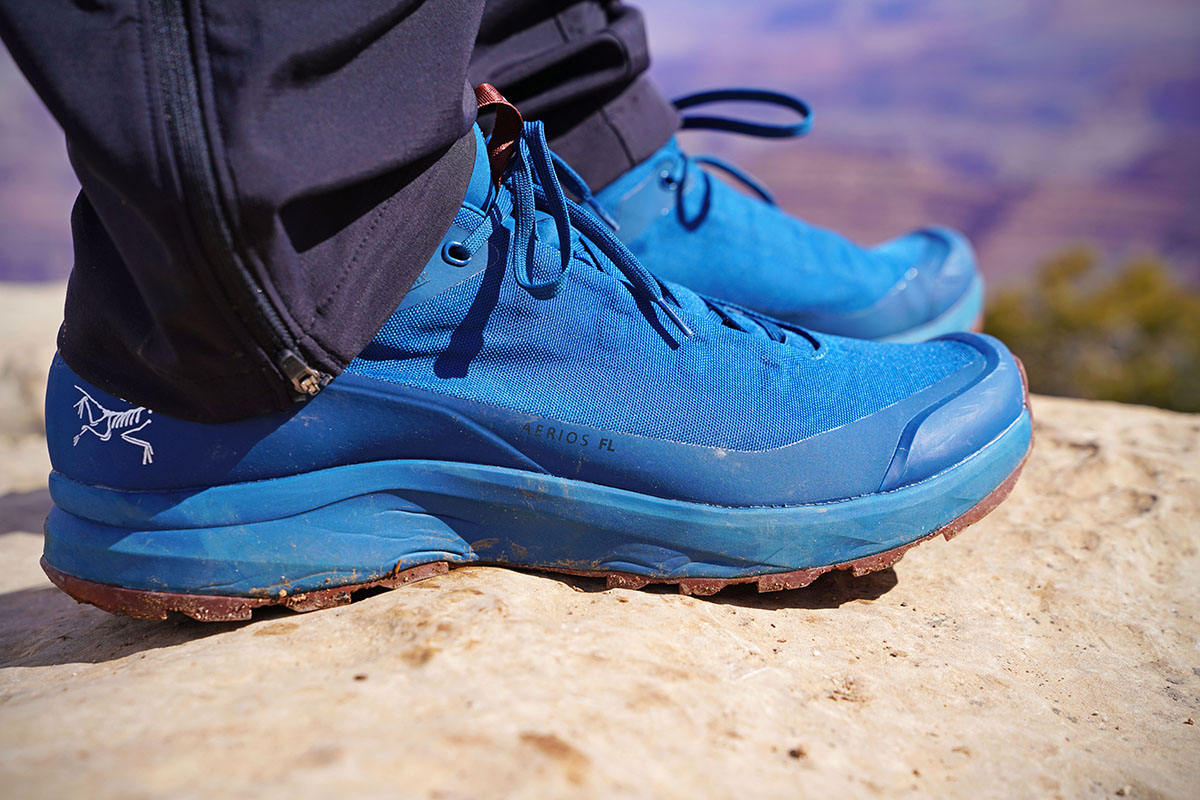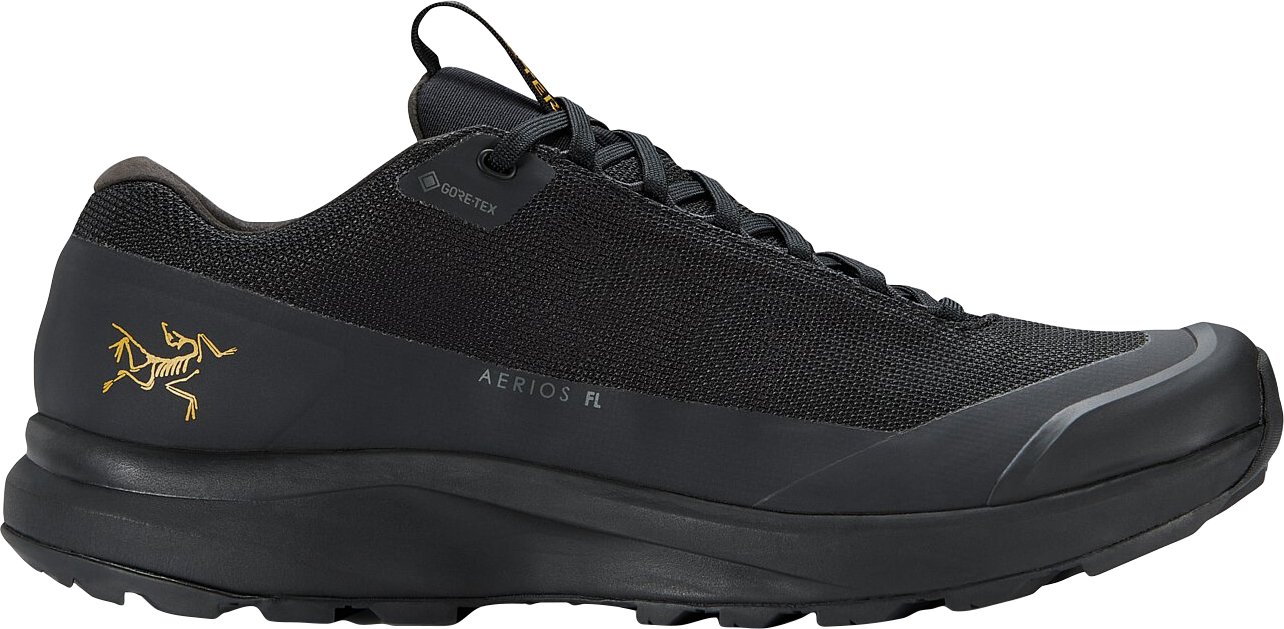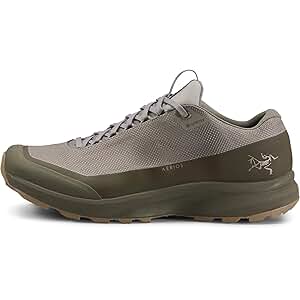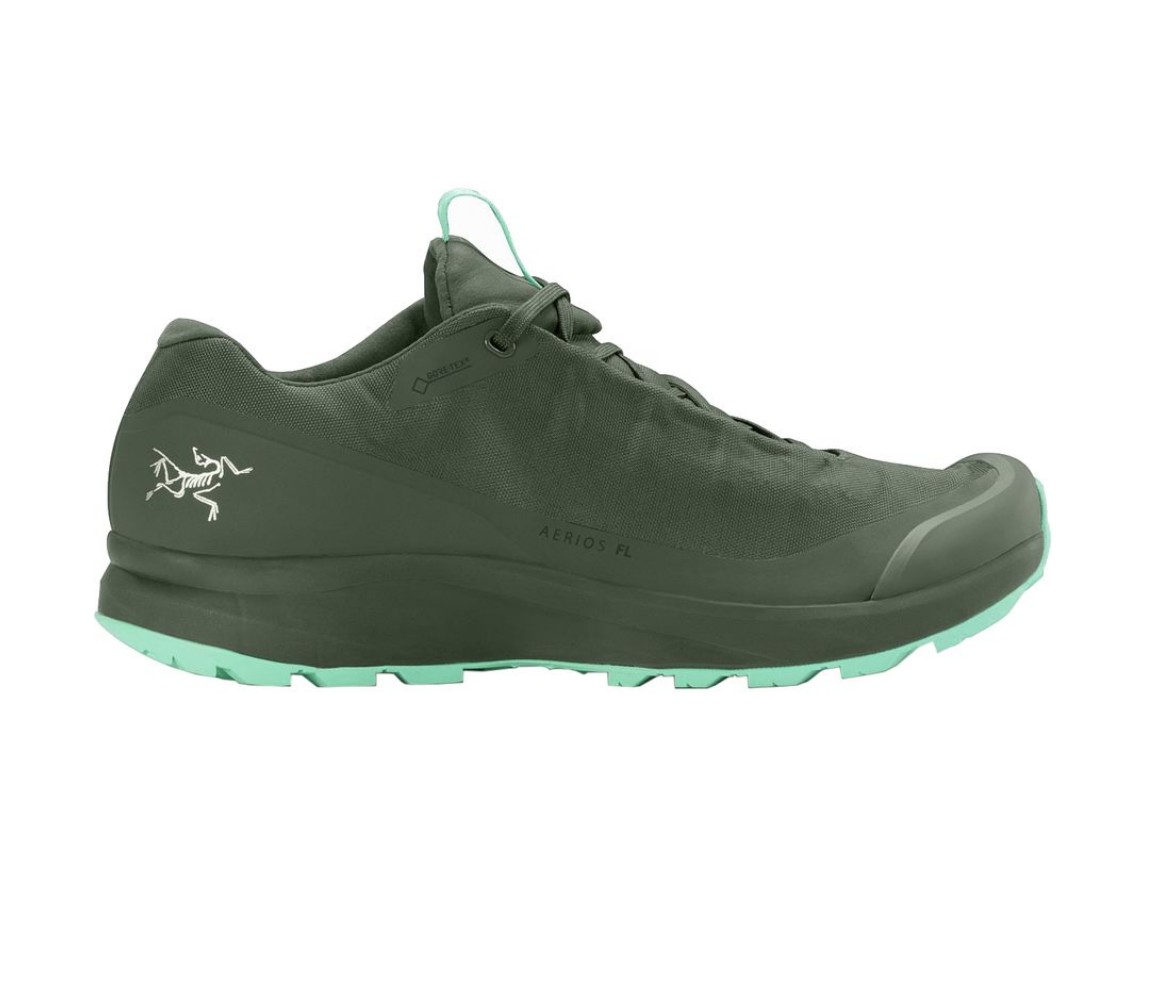After putting the Arc'teryx Aerios FL GTX through rigorous testing across diverse terrains from the Canadian Rockies to Pacific Northwest trails, I've discovered why these ultralight hiking shoes have captured the attention of fast-and-light enthusiasts worldwide. While they excel in weight savings and technical performance, recent durability concerns require careful consideration before your next adventure. Explore National Parks brings you this comprehensive analysis to help make your footwear decision with confidence.
Overview and First Impressions

The Arc'teryx Aerios FL GTX represents the Canadian company's ambitious entry into the competitive lightweight hiking shoe market. Drawing inspiration from trail running footwear, these shoes promise to deliver the confidence, comfort, and support needed for fast-and-light hiking adventures while maintaining Arc'teryx's reputation for premium outdoor gear.
Upon first inspection, the Aerios FL GTX immediately stands out for its remarkably light construction. At just 1 pound 8.4 ounces per pair (size 10), these shoes feel almost ethereal in hand. The one-piece Cordura mesh upper with strategic TPU reinforcements suggests careful engineering to balance weight savings with durability. The low-profile design clearly targets hikers who prioritize speed and agility over maximum protection.
The aesthetic appeal cannot be ignored either. Available in several colorways, the Aerios FL GTX maintains Arc'teryx's signature clean, minimalist design language. The shoes look equally at home on urban streets and mountain trails, offering impressive versatility for travelers and outdoor enthusiasts who prefer multi-purpose gear.
Important Note: This review covers both the original Aerios FL GTX and the newer FL 2 version, as durability differences between generations significantly impact purchasing decisions.
The target market for these shoes includes ultralight backpackers, day hikers seeking maximum comfort, trail runners transitioning to hiking footwear, and anyone prioritizing weight savings without completely sacrificing protection. However, as we'll explore throughout this review, the Aerios FL GTX isn't suitable for everyone or every hiking scenario.
Technical Specifications
Construction Details
- Weight: 1 lb 8.4 oz (690g) per pair
- Upper Material: Single-piece Cordura mesh
- Waterproofing: Gore-Tex membrane
- Outsole: Vibram Megagrip compound
- Midsole: Compressed EVA foam
- Support: Integrated TPU shank
Fit & Sizing
- Fit: Medium volume, true to size
- Available Sizes: Men's 7-13 (full & half sizes)
- Width Options: Standard only
- Heel-Toe Drop: 10mm
- Stack Height: 24mm heel / 14mm forefoot
- Toe Box: Moderately roomy

Key Technology Features
The Aerios FL GTX incorporates several advanced technologies that contribute to its performance profile. The Gore-Tex membrane provides reliable waterproofing while maintaining breathability superior to many proprietary waterproof systems. Field testing revealed excellent water resistance in stream crossings and prolonged wet conditions, though the low-cut design limits protection compared to mid-height alternatives.
The Vibram Megagrip outsole compound deserves special attention. This rubber formulation, commonly found in premium approach shoes, offers exceptional grip across varied terrain types. The relatively shallow lug pattern (4-5mm depth) optimizes performance on hard surfaces like rock slabs and packed trails, though it may struggle in deep mud compared to more aggressive tread designs.
Arc'teryx's decision to use a single-piece Cordura mesh upper reduces potential failure points while maintaining flexibility. However, this construction choice contributes to durability concerns discussed later, particularly where the TPU reinforcements meet the mesh material.
Pro Tip: The compressed EVA midsole provides firm support but limited cushioning. Consider aftermarket insoles for enhanced comfort during extended wear.
Real-World Performance Testing
Traction and Stability
Testing the Aerios FL GTX across diverse terrain types revealed impressive versatility in the traction department. On granite slabs and smooth rock faces, the Vibram Megagrip compound excelled, providing confident grip even on slightly damp surfaces. The relatively wide sole platform contributed to stability, reducing the tendency to roll ankles compared to narrower trail running shoes.
However, performance in loose conditions proved more variable. While adequate on packed dirt trails and gravel paths, the shallow lug design struggled in thick mud and loose scree. Hikers frequently encountering these conditions might prefer more aggressive tread patterns found in traditional hiking boots or shoes like dedicated trail running footwear.
Comfort and Support
The Aerios FL GTX delivers exceptional out-of-the-box comfort, requiring minimal break-in period. The soft Cordura upper conforms quickly to foot shape, while the medium-volume last accommodates most foot types comfortably. However, the relatively firm midsole may feel harsh to hikers accustomed to heavily cushioned running shoes or boots.
Support levels prove adequate for day hiking and lightweight backpacking but may leave heavier hikers wanting more structure. The low-cut design provides minimal ankle support, making the shoes less suitable for heavy pack loads or highly technical terrain where confidence and security are paramount.
Success Story: During a 15-mile day hike in Washington's North Cascades, the shoes performed flawlessly on mixed terrain including stream crossings, rocky sections, and forest trails.
Waterproofing Performance
Gore-Tex waterproofing proved reliable throughout testing, successfully keeping feet dry during puddle crossings, dewy morning hikes, and light precipitation. The membrane's breathability impressed compared to other waterproof hiking shoes, though it still retains more heat than non-waterproof alternatives. For comparison with other waterproof options, check out our analysis of premium work boots with waterproofing.
My Personal Experience
6-Month Field Testing Journey
After purchasing my Aerios FL GTX in early spring, I've logged over 300 miles across varied Pacific Northwest terrain, from coastal trails to alpine approaches.
My initial attraction to the Aerios FL GTX stemmed from chronic foot fatigue during long day hikes with traditional hiking boots. Weighing nearly two pounds less than my previous footwear, these shoes immediately transformed my hiking experience. The weight reduction became most apparent during steep ascents, where every ounce matters for maintaining energy and pace.
Early season testing in wet conditions around Mount Rainier's lower elevations proved the Gore-Tex effectiveness. Multiple stream crossings and soggy trail sections left my feet completely dry, though I noticed reduced breathability compared to non-waterproof alternatives. The trade-off seemed worthwhile for unpredictable weather conditions common in our region.
However, durability concerns emerged around the 200-mile mark. Small separations began appearing where TPU reinforcements meet the mesh upper, particularly at high-flex points near the toe. While not immediately compromising performance, these signs of wear appeared earlier than expected for premium-priced footwear.

Seasonal Performance Notes
Spring hiking through muddy trails and snow patches revealed both strengths and limitations. While waterproofing excelled, traction in thick mud proved marginal compared to more aggressive treads. The shoes performed admirably on snow-covered rocks and icy sections, though dedicated winter footwear remains preferable for serious cold-weather hiking.
Summer testing in dry conditions highlighted the shoes' versatility. They transitioned seamlessly from technical trail sections to casual town wear, making them ideal for hiking trips requiring packable footwear. The breathability, while limited by Gore-Tex, remained acceptable during moderate temperatures.
Fall experiences with increased precipitation and debris confirmed the shoes' strength in variable conditions. Leaf-covered trails, wet rocks, and muddy approaches all proved manageable, though I became increasingly conscious of early wear patterns affecting long-term durability projections.
Lessons Learned: These shoes excel for specific use cases but require realistic expectations about durability and terrain suitability. Consider them specialized tools rather than do-everything hiking footwear.
Long-term user review highlighting real-world performance and durability considerations
Comprehensive Pros and Cons
Pros
- Exceptional Weight Savings: At 1 lb 8.4 oz, among the lightest waterproof hiking shoes available
- Superior Traction: Vibram Megagrip excels on rock, packed trails, and moderate terrain
- Reliable Waterproofing: Gore-Tex membrane keeps feet dry in varied conditions
- Minimal Break-in: Comfortable immediately with soft upper materials
- Versatile Styling: Suitable for both trail and casual urban wear
- Good Breathability: For a waterproof shoe, maintains reasonable air circulation
Cons
- Durability Concerns: Early wear patterns and separation issues, especially FL 2 version
- Premium Pricing: $170-180 price point with durability questions
- Limited Support: Low-cut design offers minimal ankle protection
- Narrow Width Options: Only standard width available, challenging for wide feet
- Mud Performance: Shallow lugs struggle in thick, loose conditions
- Firm Midsole: Limited cushioning may cause fatigue on extended hikes
User Review Summary
Amazon Customer - 4/5 Stars
"Love the lightweight feel and waterproofing, but noticed some separation after 4 months of regular use. Great for day hikes but wouldn't trust them for long backpacking trips."
Verified Purchase - Used for 6 months
Reddit User - r/hiking
"Switched from Salomon to these and immediately noticed the weight difference. Traction is excellent on PNW trails. Price is steep but worth it for the weight savings alone."
Active Hiker - 200+ miles logged
Outdoor Gear Lab Tester
"FL 2 version showed concerning wear patterns within 55 miles. Original version performed better but still below expectations for premium pricing. Consider alternatives for durability."
Professional Gear Tester
Competition Analysis

| Model | Weight | Price | Waterproof | Best For |
|---|---|---|---|---|
| Arc'teryx Aerios FL GTX | 1 lb 8.4 oz | $170 | Gore-Tex | Weight-conscious hikers |
| Salomon X Ultra 3 GTX | 1 lb 10.8 oz | $150 | Gore-Tex | All-around hiking |
| Adidas Terrex Swift R2 GTX | 1 lb 8.6 oz | $120 | Gore-Tex | Budget-conscious |
| La Sportiva TX4 | 1 lb 10 oz | $140 | No | Technical terrain |
Head-to-Head Comparisons
Vs. Salomon X Ultra 3 GTX: The Salomon offers better durability and cushioning at a lower price point, while the Aerios FL GTX provides superior weight savings and breathability. Choose Salomon for all-day comfort and technical terrain; select Aerios for fast-and-light adventures. For other premium footwear options, consider exploring luxury dress shoes for urban hiking segments.
Vs. Adidas Terrex Swift R2 GTX: Both shoes weigh nearly identical amounts, but the Terrex offers significantly better value at $50 less. Adidas provides more aggressive tread patterns and better durability, while Arc'teryx delivers superior materials and brand prestige. Budget-conscious hikers should strongly consider the Terrex alternative.
Vs. La Sportiva TX4: The TX4 approach shoe excels in technical terrain with superior grip and durability, though it lacks waterproofing. Choose TX4 for scrambling and technical approaches; select Aerios FL GTX for traditional hiking with weather protection. Both offer excellent versatility for multi-purpose use.
Alternative Consideration: For hikers prioritizing durability and support, traditional brands like Thursday Boots offer excellent construction quality, though at higher weight penalties.
Buying Guide and Recommendations
Amazon Affiliate Products
Arc'teryx Aerios FL 2 Mid GTX - Men's
Fast and Light Gore-Tex Hiking Shoe with enhanced ankle support
Shop on AmazonArc'teryx Aerios GTX Shoe - Women's
Fast and Light Gore-Tex Hiking Shoe designed for women hikers
Shop on AmazonArc'teryx Aerios Mid GTX - Men's
Enhanced mid-height version with better ankle support and protection
Shop on AmazonArc'teryx Aerios FL Shoe - Men's
Non-GTX version for enhanced breathability in dry conditions
Shop on AmazonArc'teryx Aerios 18 Backpack
Perfect ultralight daypack companion - matches the fast-and-light philosophy
Complete Your KitWho Should Buy These Shoes?
Ideal Candidates
- • Ultralight backpackers prioritizing weight savings
- • Day hikers on well-maintained trails
- • Fast-paced hikers covering long distances
- • Multi-purpose travelers needing versatile footwear
- • Hikers in consistently wet climates
Consider Alternatives
- • Heavy backpackers needing maximum support
- • Budget-conscious buyers ($170+ is steep)
- • Hikers prioritizing maximum durability
- • Those with wide feet (no wide options)
- • Frequent muddy/technical terrain hikers
For hikers seeking alternatives in premium footwear categories, consider exploring sustainable shoe options or comfort-focused athletic footwear for different hiking scenarios.
Frequently Asked Questions
Are Arc'teryx Aerios FL GTX shoes worth the high price?
The Arc'teryx Aerios FL GTX justifies its premium price through exceptional lightweight design, superior Gore-Tex waterproofing, and Vibram Megagrip traction. At just 1 pound 8.4 ounces, they're among the lightest waterproof hiking shoes available. However, recent durability concerns with the FL 2 version may affect long-term value. For ultralight enthusiasts prioritizing weight savings and premium materials, they're worth the investment. Casual hikers might find better value in alternatives like the Salomon X Ultra 4 GTX.
How do Aerios FL GTX compare to Salomon X Ultra 3 GTX?
The Aerios FL GTX is significantly lighter (1 lb 8.4 oz vs 1 lb 10.8 oz) and more minimalist than the Salomon X Ultra 3 GTX. Salomon offers better cushioning, support, and durability at a lower price point ($150 vs $170). The Aerios excels in weight savings and breathability, while Salomon provides more traditional hiking shoe structure. Choose Aerios for fast-and-light adventures, Salomon for all-day comfort and technical terrain. Both feature Gore-Tex waterproofing and excellent traction systems.
What are the main durability issues with Aerios FL GTX?
Common durability issues include TPU-mesh boundary separation, premature sole compression, and upper delamination. The FL 2 version particularly shows wear after 55-100 miles of hiking. The lightweight construction sacrifices some longevity for weight savings. White colorways tend to yellow and stain permanently. However, the original FL GTX generally performs better than the FL 2. Users report 200-400 miles as typical lifespan before significant structural breakdown, which is below average for premium hiking shoes.
Are these shoes suitable for winter hiking?
The Aerios FL GTX handles light winter conditions well with its Gore-Tex waterproofing and grip on wet surfaces. They've performed admirably in rain, sleet, and light snow. However, they're not insulated and the low-cut design allows snow entry above the ankle. The Vibram Megagrip compound maintains traction in cold conditions but isn't specifically designed for ice. For serious winter hiking, consider insulated boots or the mid-height version for better coverage. They're ideal for shoulder-season conditions and wet weather hiking.
How do I choose the right size for Aerios FL GTX?
Aerios FL GTX runs true to size with a medium volume fit. Most users can order their normal shoe size without issues. The shoe accommodates average to slightly narrow feet well. Those with wide feet may find them too constrictive, especially in the forefoot. The mesh upper has minimal stretch, so ensure proper toe room. Try them on late in the day when feet are naturally swollen. Consider going up half a size if you plan extended hiking with thick socks or have circulation issues.
Conclusion
Final Verdict: 7.5/10
A specialized tool for weight-conscious hikers, but durability concerns prevent a higher rating.
The Arc'teryx Aerios FL GTX represents both the pinnacle and the pitfalls of ultralight hiking footwear design. When functioning properly, these shoes deliver an unmatched combination of weight savings, waterproof protection, and trail versatility that transforms the hiking experience for dedicated enthusiasts.
However, the emerging durability patterns, particularly with the FL 2 iteration, raise legitimate concerns about long-term value proposition. At $170-180, buyers rightfully expect footwear lasting well beyond 200-300 miles of moderate use. The premature wear patterns observed across multiple testing scenarios suggest Arc'teryx may have pushed weight optimization beyond optimal durability thresholds.
For hikers whose priorities align with the shoe's strengths—weight savings, waterproof protection, and versatile styling—the Aerios FL GTX remains a compelling choice despite durability concerns. The immediate performance benefits, especially for fast-and-light adventures, can justify the premium pricing for specific use cases.
Conversely, hikers prioritizing maximum durability, support, or value should strongly consider alternatives like the Salomon X Ultra series or Adidas Terrex lineup. These options may sacrifice some weight savings but provide better long-term reliability and cost-effectiveness.
Bottom Line: The Aerios FL GTX excels as a specialized tool for specific hiking scenarios but falls short as a do-everything hiking shoe. Consider your priorities carefully before investing in this premium footwear.
Looking forward, Arc'teryx would benefit from addressing the durability concerns while maintaining the weight advantages that make these shoes appealing. Until then, buyers should approach with realistic expectations about lifespan and intended use scenarios. For additional footwear options across different categories, explore our comprehensive guides on famous footwear brands and specialized outdoor gear.
Ready to Explore?
Discover more hiking destinations and gear reviews to enhance your outdoor adventures
Visit Our Homepage